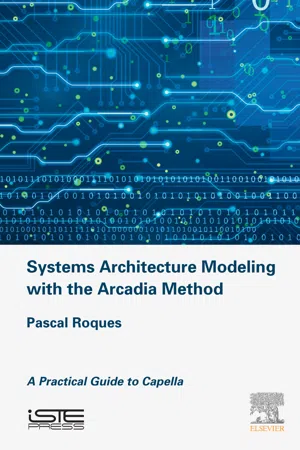
Systems Architecture Modeling with the Arcadia Method
A Practical Guide to Capella
- 292 pages
- English
- ePUB (mobile friendly)
- Available on iOS & Android
About this book
Systems Architecture Modeling with the Arcadia Method is an illustrative guide for the understanding and implementation of model-based systems and architecture engineering with the Arcadia method, using Capella, a new open-source solution.More than just another systems modeling tool, Capella is a comprehensive and extensible Eclipse application that has been successfully deployed in a wide variety of industrial contexts. Based on a graphical modeling workbench, it provides systems architects with rich methodological guidance using the Arcadia method and modeling language. Intuitive model editing and advanced viewing capabilities improve modeling quality and productivity, and help engineers focus on the design of the system and its architecture.This book is the first to help readers discover the richness of the Capella solution.- Describes the tooled implementation of the Arcadia method- Highlights the toolset widely deployed on operational projects in all Thales domains worldwide (defense, aerospace, transportation, etc.)- Emphasizes the author's pedagogical experience on the methods and the tools gained through conducting more than 80 training sessions for a thousand engineers at Thales University- Examines the emergence of an ecosystem of organizations, including industries that would drive the Capella roadmap according to operational needs, service and technology suppliers who would develop their business around the solution, and academics who would pave the future of the engineering ecosystem
Frequently asked questions
- Essential is ideal for learners and professionals who enjoy exploring a wide range of subjects. Access the Essential Library with 800,000+ trusted titles and best-sellers across business, personal growth, and the humanities. Includes unlimited reading time and Standard Read Aloud voice.
- Complete: Perfect for advanced learners and researchers needing full, unrestricted access. Unlock 1.4M+ books across hundreds of subjects, including academic and specialized titles. The Complete Plan also includes advanced features like Premium Read Aloud and Research Assistant.
Please note we cannot support devices running on iOS 13 and Android 7 or earlier. Learn more about using the app.
Information
Reminders for the Arcadia Method
Abstract
Keywords
1.1 Novelties, strengths and principles
1.1.1 History
1.1.2 Founding principles
Table of contents
- Cover
- Title page
- Table of Contents
- Copyright
- Foreword
- Preface
- 1: Reminders for the Arcadia Method
- 2: Capella: A System Modeling Solution
- 3: Complete Example of Modeling with Capella: Operational Analysis
- 4: Complete Example of Modeling with Capella: System Analysis
- 5: Complete Example of Modeling with Capella: Logical Architecture
- 6: Complete Example of Modeling with Capella: Physical Architecture
- 7: Complete Example of Modeling with Capella: EPBS
- Conclusion: Capella’s Key Strengths
- Bibliography
- Index